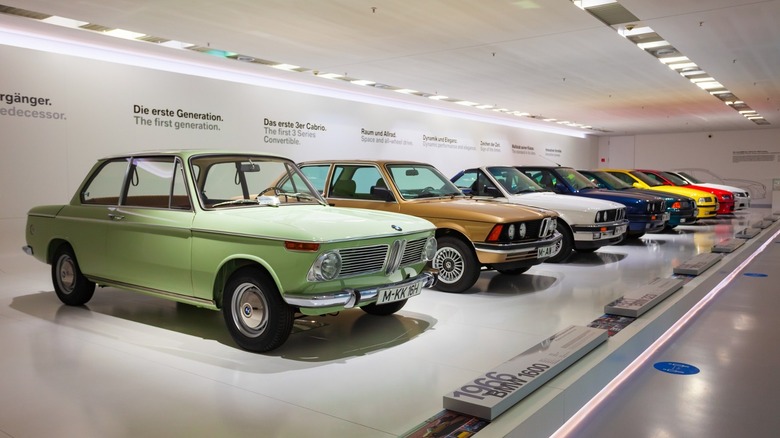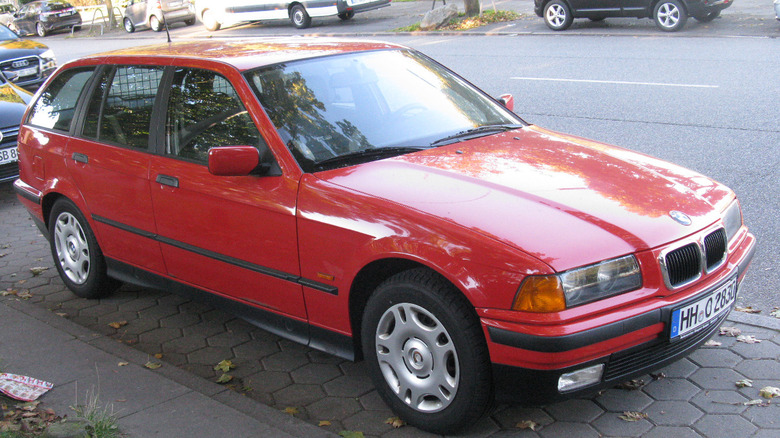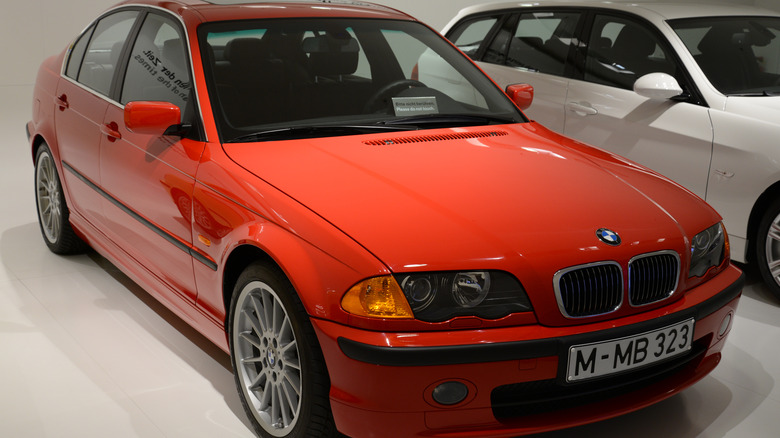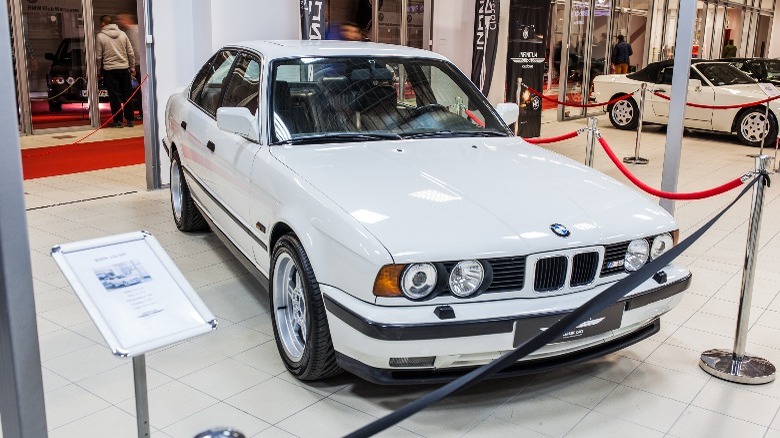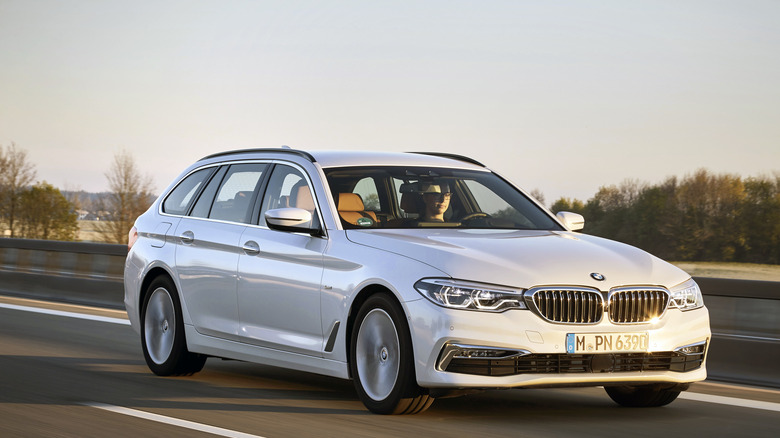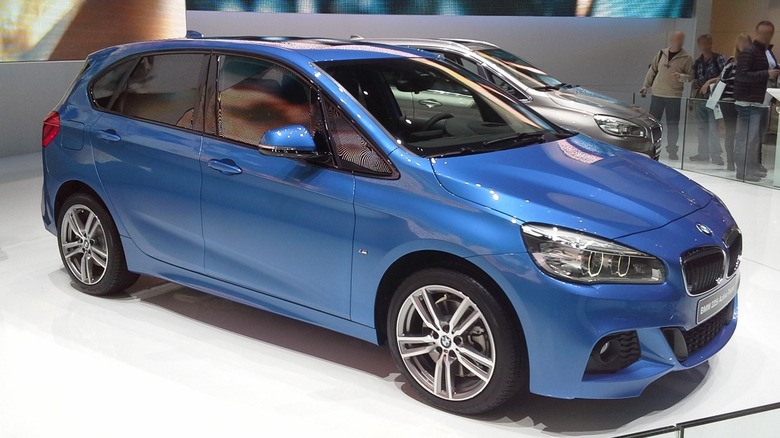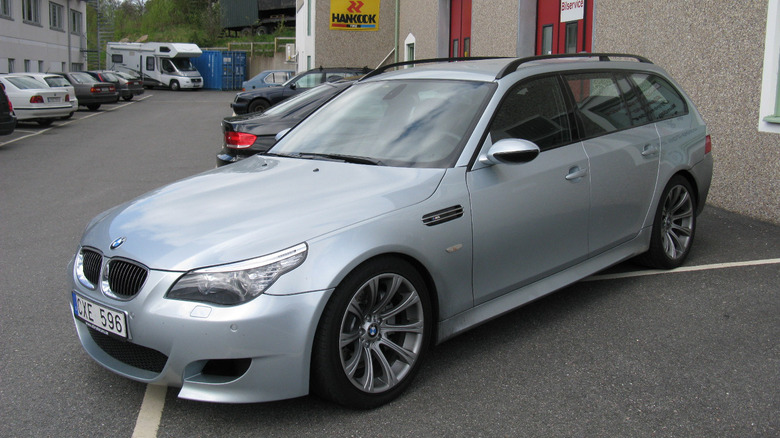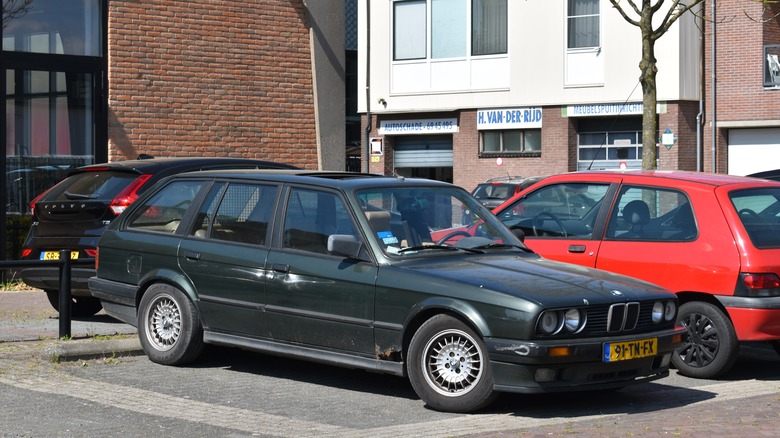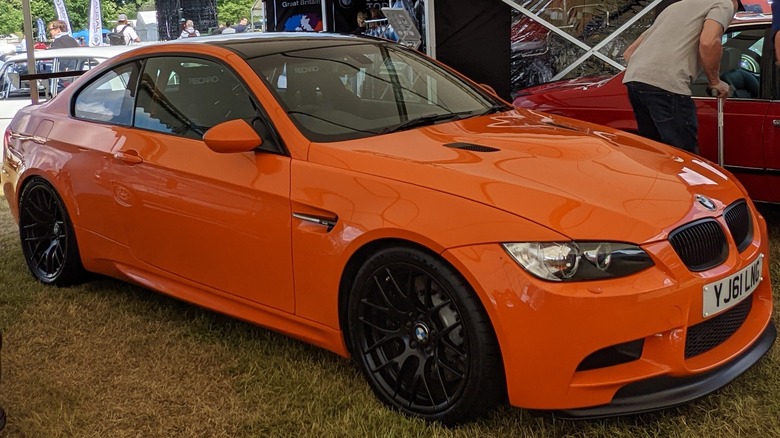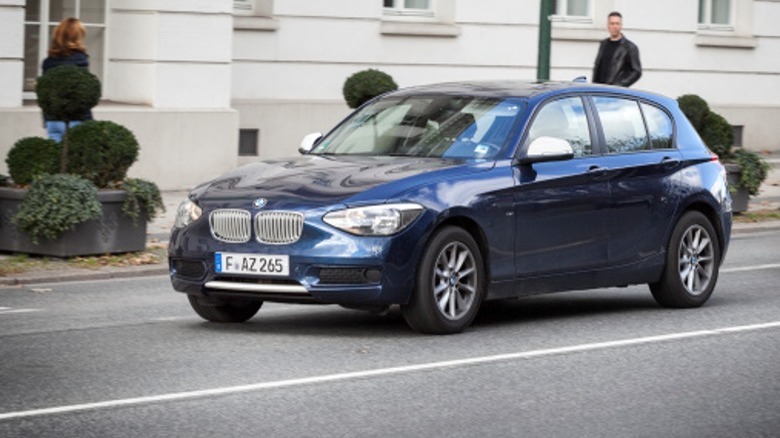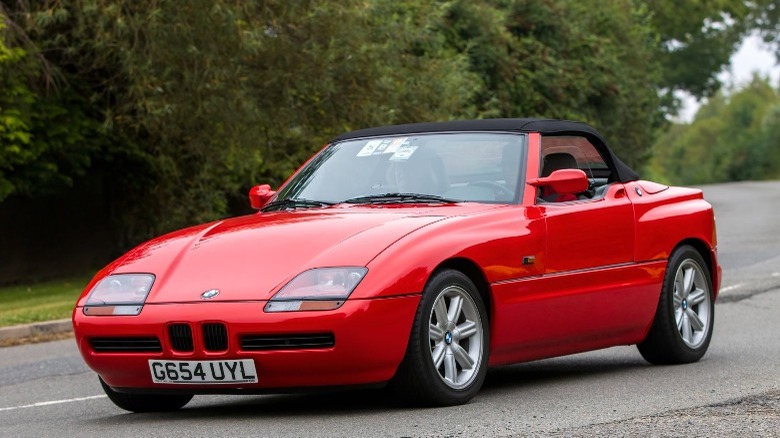10 Iconic BMW Cars That Didn't Make It To The United States
World-renowned German vehicle manufacturer BMW is credited with the production of some of the most stylish, and iconic cars in automotive history. From coupes and convertibles to sedans and SUVs, the company has blazed a trail for its production of reliable, snazzy, and multifaceted vehicles.
Perhaps surprisingly, some of these vehicles failed to reach American soil, for a variety of reasons. Some of these include, but are not limited to, production peculiarities, market competition, and regulation compliance. In fact, some cars were withheld from U.S. shores simply because of limited production or fears of internal competition from an already available, better-performing vehicle in the same range.
Whatever influence the boardroom and the market had on those decisions, what is certain is that America has been denied some absolute gems. From the M5 Touring to the incredibly limited E92 M3 GTS, here are 10 iconic BMWs that never made it to the United States.
BMW E36-Generation 3-Series Station Wagon
The BMW 3-series is responsible for producing some of the most underrated cars ever. Produced under the E36 model, the third generation of the 3-series emerged in 1991 and was halted in 1998. The car was initially released as a four-door sedan with subsequent additions of coupe, convertible, and wagon style. However, the station wagon never made it to the U.S. market.
We cannot talk about this car without paying respect to its engine options. It comes with petrol and diesel engines. The petrol engines come in 316i, 318i, 320i, 323i and 328i types. The 328i variant is a six-cylinder, 2.8-liter engine with up to 190 horsepower. The diesel engines come in 325td and 325tds types, both of which are six cylinder 2.5-litre capacity.
The car's design also exudes simplicity and class. It has a boxy shape with curves around the headlamps which make it look very similar to elegant sedans. What sets it apart is the extended roofline which allows for more cargo space. If you prefer dimensions, the car's length is approximately 14.6 feet with a width of approximately 5.6 feet and a height of 4.6 feet.
[ Featured Image by nakhon100 via Wikimedia Commons | Cropped and scaled | CC BY-2.0 ]
BMW E46-generation 3-Series Compact
When BMW stopped producing the E36 3-series, it swiftly replaced it with the E46 3-series, introduced in 1997. These cars are a range of compact executive vehicles manufactured in convertible, coupe, hatchback, sedan, and station wagon styles. The hatchback style was produced between 2001 and 2004.
The BMW E46 3-Series' primary target market was young people who sought to mix the high-quality interior and snazzy design of a sporty car with the practicality and affordability of a compact hatchback. However, it was not made available stateside due to the same concerns as its predecessor, which was competition from SUVs.
The 3-Series Compact was available with a choice of inline-four and inline-six engines, with gasoline and diesel options. The gas engine types ranged from 1.6-liter to 2.5-liter while the diesel engine came in a 2.0-liter option. Also a maximum of 189 hp meant it came with good acceleration while maintaining steady handling.
In terms of size, it is 13.9 feet in length, with a width of 5.7 feet and a height of 4.6 feet. It also features a wheelbase that measures 107.3 inches.
BMW E34 M5 Touring
Few cars are as remarkable and iconic as the BMW E34 M5 Touring. Initially released as a sedan, this entry into the storied 40-year-old M5 line earned acclaim for its capabilities as a sports car, with a 3.5-liter inline-six engine producing up to 315 hp. And it was no joke when it came to speed: The M5 could go from 0-62 mph in only 6.3 seconds.
When the wagon version was first released in 1992, BMW described it as a sportscar mellowed out with a more modest design. And it was not wrong. The M5 Touring is a motorsports car cosplaying as a family car and this allows owners to get the best of both worlds.
The car has a notably distinctive M badging on the front grille, rear hatch, and side moldings. It is approximately 15.5 feet long, 5.8 feet wide, and 4.6 feet high with a wheelbase of 109 inches.
The car is great for traveling long distances but neither the sedan or station wagon variations were officially sold in the U.S. This was due to the limited number produced and the station wagon's lack of popularity at the time.
BMW F10-generation 5-Series Touring
BMW's popular 5 series vehicles are heralded by the F10 station wagon. Introduced in 2011, it was the first 5 Series to offer a hybrid drivetrain as well as a turbocharged V8 engine, and it was not offerecd in the United States.
The outstanding feature of this vehicle is its design. On the exterior, the front bumper is designed with integrated air intake and fog lights, the sides have a sleek and aerodynamic long hood with a straight roofline, and the rear features dual exhaust outlets, all of which give it a sporty look.
The interior is equally as outstanding with luxurious leather, soft-touch plastics, and high-quality aluminum constituting the majority of its makeup. The cockpit is elegantly designed with the centrepiece being the 10.2-inch LCD display powered by the iDrive 7 system.
Up until the introduction of the F10 station wagon, every 5 series wagon had been officially sold in the U.S. One reason for this change was to help sell more models of the 5 series GT.
BMW 2-Series Active Tourer
One of the more modern BMWs on our list is the 2-series Active Tourer which was produced in 2014. The Active Tourer is a subcompact executive multi-purpose vehicle tailor-made for urban driving, as highlighted by the introduction of front-wheel drive, a departure from BMWs traditional rear wheel drive.
The subcompact executive minivan was thought to be a European-exclusive vehicle too small for the U.S. — a sentiment that was also accorded its Grand Tourer version. Its urban friendliness is reflected in the vehicle's range of engines which includes gas, diesel, and plug-in hybrid varieties.
For the petrol variant, the choice is between a 1.5-liter three-cylinder and 2.0-liter four-cylinder 220i and 223i engines respectively, that offer between 170 hp and 218 hp. The diesel variant similarly includes a 1.5-liter three-cylinder and a 2.0-liter four-cylinder 218d engine, with power ranging from 116 hp to 190 hp. Lastly, the plug-in hybrid variant combines a petrol engine with an electric motor, that results in a combined output of up to 326 hp which goes from 0-62mph sprint in 5.5 seconds.
[ Featured Image by Navigator84 via Wikimedia Commons | Cropped and scaled | CC BY-SA 3.0 ]
BMW E61 M5 Touring
The second M5 Touring on our list is the E61. The BMW E61 M5 Touring was produced between 2007 and 2010 and is a five-door wagon with a V10 engine that is based on the E60 5-Series platform.
On its exterior, the E61 M5 Touring features edgy lines, highlighted fenders, and distinctive headlights which give it a sporty look. It also has an extended roofline and rear cargo space which adds practicality to its style and overall versatility. The interior is highlighted by its spacious and luxurious design, which uses high-quality materials, advanced technology, and a driver-centric cockpit that allows for both performance driving and family use.
As mentioned earlier, the car has a 5-liter V10 engine that produces power of 500 hp and 383 Ib-ft of torque. For transmission, it features a standard seven-speed sequential manual gearbox (SMG) that offers both automatic and manual shift modes. Astonishingly, it can accelerate from 0 to 60 mph in approximately 4.5 seconds, making it one of the fastest station wagons of its time.
BMW claims that just over a thousand of these vehicles were produced and none of them were officially sold in the U.S.
[ Featured Image by nakhon100 via Wikimedia Commons | Cropped and scaled | CC BY 2.0 ]
BMW E30-Generation 3-Series Station Wagon
The BMW E30-generation 3-Series is an outstanding collection of cars produced between 1982 and 1994, which came in coupe, convertible, and station wagon varieties. The station wagon variant was introduced in 1987 as a vehicle that combines the performance of a sports car with the practicality and reliability of a family car.
The exterior of the E30 station wagon is pretty standard is standard as noted from its boxy appearance which is the same as the other cars in the series. It is approximately 14.9 feet long, 5.4 feet wide, and 4.5 feet high. Its wheelbase is also approximately 101 inches.
It came in a variety of engine options, including an inline four-cylinder 1.8-liter petrol engine with up to 111hp and also a six-cylinder 2.5-liter petrol engine with up to 168hp.
The station wagon was withheld from the U.S. majorly due to stiff competition from the Mercedes Benz E-class which was very similar and more popular. It also faced internal competition from the BMW E34 Generation 5 series.
BMW E92 M3 GTS
This might just be one of BMW's top regrets. The 2011 BMW E92 M3 GTS only saw 138 of its kind ever built, with none being officially sold stateside. Initially, the coupe was a track-focused car, but subsequent modified options were available for owners who wanted it road-worthy.
The E92 M3 GTS looks like a typical sports car, with its most prominent feature being its fire orange color. The front of the car features a pronounced carbon fiber splitter that enhances downforce and aerodynamics. It also has carbon fiber side mirrors and lightweight polycarbonate windows as well as a rear bumper with a carbon fiber diffuser that is helpful in managing airflow and improving stability at high speeds.
At the heart of the car is a 4.4-liter V8 engine with a power output of approximately 450 hp. The engine is an enlarged version of the standard M3's 4.0-liter V8 and this means the power output also enjoys a significant increase. The engine also features a high-revving design, individual throttle bodies, and a lightweight construction. So yeah, it is an ultra-cool but super-limited sports car.
[ Featured Image by Calreyn88 via Wikimedia Commons | Cropped and scaled | CC BY-SA 4.0 ]
BMW 1-Series Hatchback
The penultimate entry on our list is quite fittingly a first-generation vehicle. Introduced in 2004 as a compact and affordable car, the BMW 1 Series came in coupe, convertible, and hatchback varieties. The hatchback replaced the compact and came in three-door and five-door styles. Its premium build and urban driving capabilities made it an extremely popular choice in the market, though it is still being denied from official sale stateside.
The car's popularity has seen it survive through three generations of production. The first generation features rear-wheel drive and a wide range of engines from four-cylinder to six-cylinder with a variety of gas and diesel options ranging from the 116i to the 130i variants. The second generation, which began production in 2011, retained the rear wheel drive feature with a range of petrol and diesel engines, including the high-performing M135i and M140i variants.
The third generation which only began in 2019 switched to a front wheel drive with three-cylinder and four-cylinder engines that featured the M135i xDrive variant. The third generation is also exclusively produced in five-door styles as it did away with the three-door style option.
BMW Z1
Last but certainly not least is the BMW Z1, which was produced between 1989 and 1991. The car is a two-seater convertible and was the first in BMW's Z series. Even today, it remains a collector's dream and an all-time classic.
The car had a sleek aerodynamic design that was tailor-made to catch the eye of anyone who stumbles upon it. It featured pop-up headlights, retractable doors, alloy wheels, and dual exhaust pipes that gave it an extremely sporty appearance.
On the inside, it was powered by a 2.5-liter inline-six engine that produced about 168 hp and 164 lb-ft of torque. It also stood out as one of the first cars to utilize thermoplastic body panels, which are lighter in weight and dent-resistant.
The BMW Z1 had lots of cool features, but over the course of its short production cycle, no units made it to North America. The vehicle's production was limited to 8,000 units which is surprising considering its potential marketability among American high schoolers and college students at the time. Even more regrettable is that it was pulled from production due to low demand in Germany.
